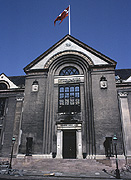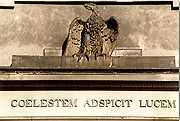| Date: | 1845. |
| Form: | Three stanzas, each containing four three-stress lines with the rhyme scheme AbCb and the alliteration pattern 22. |
| Manuscript: | KG 31 a II, which contains two copies: an untitled version (facsimile KJH275; image) and a version with the title "Hornbjarg" (facsimile KJH288; image). |
| First published: | 1847 (A234; image). |
Jónas the scientific traveller had never visited Horn Crag. But Jónas the zoologist was intimately familiar with Icelandic eagles, having devoted some hours in February 1841 to measuring and dissecting a pair of specimens (3D132-3, 2E66). We should not forget the scientist's sober, hands-on experience while contemplating the various eagles — the white eagle from Greenland, the stone eagle in Copenhagen, Plato's eagle, Heine's eagle, P. L. Møller's eagle — that wing their way through this poem.
Jónas's footnote appears in the later of the two manuscripts and shows that the initial inspiration for the poem was a statement by Jón Guðmundsson "the Learned" (1574-1658). This statement reads in full: "Along with the drift ice [from Greenland] come white bears, white falcons and foxes, white-flecked ravens. And a single all-white eagle built a nest in the bird-cliffs on Horn Strand, in my memory" (15Ísl14). Jón's statement appears in a chapter about different kinds of seals in his Brief Treatise about Iceland's Characteristic Qualities (Ein stutt undirrietting um Íslands adskilianlegar náttúrur), written probably in 1640-4. Jónas probably regarded Jón the Learned as an important (if somewhat zany) predecessor in the field of natural science. At the time of writing "Horn Crag" he seems to have been reading Jón's Brief Treatise in connection with his own work on the "Description of Iceland" — perhaps specifically in connection with the section on islands and offshore rocks.1
But the white eagle in its aerie on Horn Crag is not the only eagle that is on Jónas's mind. In Denmark, walking on an almost daily basis past the main doorway of Copenhagen University, he will have seen — perched on the architrave — a gilded statue of an eagle, life-size and with its head lifted in attentive scrutiny. Beneath this eagle, incised in large capitals, is the Latin inscription COELESTEM ADSPICIT LUCEM ("It looks at the celestial light"). The eleventh line of Jónas's original is a straightforward translation of this Latin inscription and in the earlier of his two manuscripts of the poem — lest we miss the point — he has put the words "looks at the celestial light" in quotation marks and provided them with the exclamatory footnote: "Coelestem adspicit lucem!"
The eagle as a symbol for thought or contemplation is ancient; Plato represented the soul as an eagle. Later the eagle that soars up to stare into the sun (i.e., to gaze at truth) was frequently used as a symbol for both the rapture of spiritual contemplation and the scrutiny of scientific investigation. At about the time he wrote "Horn Crag," Jónas produced a very beautiful and moving Icelandic translation of "Sjælevandring" ("Transmigration"), a poem by Peder Ludvig Møller (1814-1865); this poem had just been published in the inaugural issue (1845) of Møller's aesthetic annual Gæa.2 Jónas's translation, entitled "Arngerðarljóð" ("The Lay of Arngerður"), is a dramatic monologue spoken by an Icelandic farm girl who recalls — with poignant regret — her previous incarnation as an eagle: "The wind whistled in my dark feathers. I flew through the dim storm. The lofty sun — nothing else! — nourished the strength of my eyes." One day the eagle flew down to take a look at the "powerfully evil earth" (illskuramma jörð) and was shot dead, later to be reborn as a human being. "Now I must sit in my black clothes among little fainthearted children, cowering here on this cold island. They all call me a beautiful young girl. They don't understand that I am really an eagle." The poem offers a very moving picture of the free aspiring soul imprisoned by its body, by circumstances, by human limitations. The points of connection between it and "Horn Crag" need not be labored.
"Horn Crag," despite its surface simplicity, is complex in its suggestiveness, and its ironies are ambiguous (and ultimately opaque). If we assume that Jónas identifies himself with the bird, then it is possible to interpret the poem (1) as a portrait of the poet-seer as eagle (a concept frequent in Jónas), elevated far above (and sublimely indifferent to) the catastrophes of the nether world, while he stares into the sun of truth; or (2) as a portrait of the individual who, by virtue of "a soul of steel, insensible to harm", rises above adverse destiny in all its forms (disappointment in love, professional disappointment — neither of which was unknown to Jónas). If one follows this line of interpretation, one soon begins to suspect that Heine's poem "Wandere!" (Neue Gedichte, "Zur Ollea," IV) underlies "Horn Crag":
Wenn dich ein Weib verrathen hat,
So liebe flink eine Andre;
Noch besser wär' es, du ließest die Stadt —
Schnüre den Ranzen und wandre!
Du findest bald einen blauen See,
Umringt von Trauerweiden;
Hier weinst du aus dein kleines Weh
Und deine engen Leiden.
Wenn du den steilen Berg ersteigst,
Wirst du beträchtlich ächzen;
Doch wenn du den felsigen Gipfel erreichst,
Hörst du die Adler krächzen.
Dort wirst du selbst ein Adler fast,
Du bist wie neugeboren,
Du fühlst dich frei, du fühlst du hast
Dort unten nich viel verloren. (2HHS95)
Alternatively (or indeed simultaneously) one can imagine that Jónas identifies himself with the sinking ship and its passengers (see his poem "Ó, þú jörð"),3 in which case — if we recall the Copenhagen eagle's symbolic significance — Jónas's poem can be taken to suggest that the tragedies and sufferings of human beings are a matter of profound indifference to nature, and perhaps even to nature's God.
Notes
1 Jón's chapter "Concerning Islands and Islets around Iceland, Both Close Inshore and at the Edge of the Deep Ocean" (15Ísl13-5) will naturally have been of considerable interest to Jónas. It has been claimed that Jónas was not familiar with the Brief Treatise when he compiled his own Mammalia Islandiae (4E525); he certainly knew it by the time he wrote "Horn Crag." In Jónas's day, Jón's text was easily accessible in numerous manuscript copies (see 15Íslxxiii). Today it is available edited, with copious introduction and notes (in English), in 15Ísl.
2 On Møller and his publishing activities see Harald Jörgensen, Tidsskriftspressen i Danmark indtil 1848 (København: Berlingske Forlag, 1961), pp. 51-2.
3 One senses the presence, somewhere in the background of "Horn Crag," of Bjarni Thorarensen's magnificent elegy on Jón Jónsson (ca.1779-1817), a teacher at Bessastaðir who died off Snæfellsnes in the wreck of the postship Anne Dorothea in March 1817 — a famous disaster (for details see 2BTL58). Jónas knew this poem of Bjarni's by heart while still a student at Bessastaðir and Páll Melsteð remembered hearing him recite it during the winter of 1828-9 (4E43).


